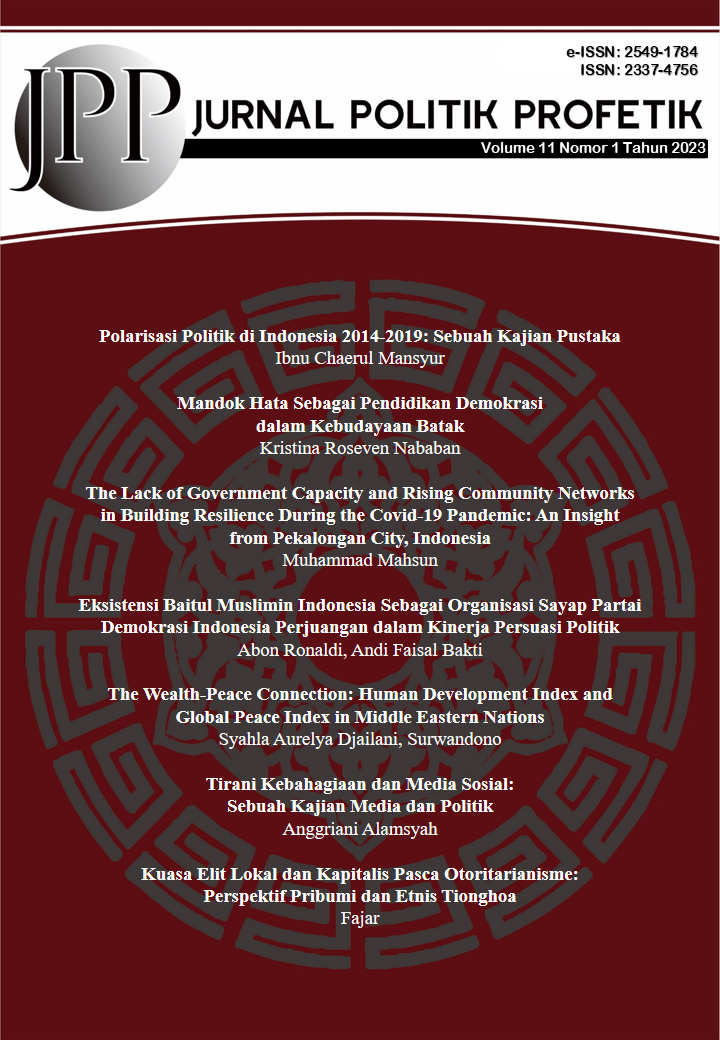The Wealth-Peace Connection: Human Development Index and Global Peace Index in Middle Eastern Nations
Abstract
This study investigates the relationship between the Human Development Index (HDI) and the Global Peace Index (GPI) in the Middle East. This quantitative analysis employs the Pearson correlation coefficient formula, with HDI as the independent variable and GPI as the dependent variable. The literature review utilizes numerous sources, including journals, books, news media, and the internet. The research sample included Yemen, Afghanistan, Iraq, the United Arab Emirates (UAE), Palestine, Saudi Arabia, Syria, Qatar, and Israel. HDI and GPI are strongly negatively correlated (-0.854), indicating that an increase in one variable (HDI) diminishes the other variable (GPI). Consequently, countries in the Middle East with higher levels of human development tend to have lower GPI scores, indicating that higher levels of human development are associated with a greater likelihood of peace in this region.
Downloads
References
Appiah, M., Amoasi, R., & Frowne, D. I. (2019). Human Development and Its Effects on Economic Growth and Development. International Research Journal of Business Studies, 12(2).
Assouad, L. (2020, March 12). Inequality and Its Discontents in the Middle East. Retrieved May 15, 2023, from Carnegie website: https://carnegie-mec.org/2020/03/12/inequality-and-its-discontents-in-middle-east-pub-81266
Aydin, M. (2019). The Relationship between Human Development and Economic Growth: Empirical Study on Turkey. Retrieved from www.siyasetekonomiyonetim.org
Balci, E., & Özcan, S. (2019). İNSANİ GELİŞMİŞLİK VE BÜYÜME ARASINDAKİ İLİŞKİ: OIC ÜLKELERİ ÜZERİNDE BİR ANALİZ. Retrieved from http://www.mfa.gov.tr/islam-isbirligi-teskilati.tr.mfa
Chikalipah, S., & Makina, D. (2019). Economic growth and human development: Evidence from Zambia. Sustainable Development, 27(6), 1023–1033.
Egan M. (2020). The Relationship between Human Development Index and Global Peace Index: Evidence from Middle East and North African (MENA) Countries. Sustainability.
England, A. (2022). Middle East states set for $1.3tn oil windfall, says IMF. Retrieved May 15, 2023, from Financial Times website: https://www.ft.com/content/94825404-e0a2-4a18-ab8d-2bc61fc7c1ab
ERDEM, E., & ÇELİK, B. (2019). İNSANİ GELİŞME VE EKONOMİK BÜYÜME İLİŞKİSİ: BAZI AFRİKA ÜLKELERİ ÜZERİNE BİR UYGULAMA. Bingöl Üniversitesi Sosyal Bilimler Enstitüsü Dergisi.
Ghazalian, P. L., & Hammoud, M. (2021). The Peace Level of Nations: An Empirical Investigation into the Determining Factors. Defence and Peace Economics, 32(5), 509–532.
Institute for Economics & Peace. (2022). Global Peace Index 2022: Measuring peace in a complex world. Retrieved from http://visionofhumanity.org/resources
Lashmar, H. (2018, March 19). The Human Development Index – a better indicator for success? Retrieved May 19, 2023, from SDG Action website: https://sdg-action.org/the-human-development-index-a-better-indicator-for-success/
Le, T. H., Bui, M. T., & Uddin, G. S. (2022). Economic and social impacts of conflict: A cross-country analysis. Economic Modelling, 115.
Ozcan, G., & Karter, C. (2020). The Relationship of Economic Growth And Terrorism with the Human Development Index: A Causality Analysis on MENA Countries.
Parker, A. (2021, April 28). Understanding the Economic Value of Peace. Retrieved May 15, 2023, from The Borgen Project website: https://borgenproject.org/the-economic-value-of-peace/
Ruslin, I. T. (2013). Memetakan Konflik di Timur Tengah (Tinjauan Geografi Politik). Jurnal Politik Profetik, 1 (1).
Saleh, A., & Ibrahim, L. (2022, September 8). UAE ranks 26th globally, 1st regionally in UNDP’s Human Development Report. Retrieved May 16, 2023, from Zawya website: https://www.zawya.com/en/economy/gcc/uae-ranks-26th-globally-1st-regionally-in-undps-human-development-report-s16qk1i6
Santhirasegaram, S. (2008). Peace and Economic Growth in Developing Countries: Pooled Data Cross-Country Empirical Study. Peace and Economic Growth in Developing Countries: Pooled Data Cross-Country Empirical Study. Retrieved from https://www.researchgate.net/publication/248395441
Sherman, M. (1999). Middle Eastern Realities: Stable Geology and Volatile Politics. In The Politics of Water in the Middle East (pp. 42–47). London: Palgrave Macmillan UK.
Turak, N. (2023, March 9). ‘Our phones are ringing off the hook’: Amid a global downturn, the finance world is chasing Middle Eastern money. Retrieved May 15, 2023, from https://www.cnbc.com/2023/03/09/amid-global-downturn-the-finance-world-is-chasing-middle-eastern-money.html website: https://www.cnbc.com/2023/03/09/amid-global-downturn-the-finance-world-is-chasing-middle-eastern-money.html
Wang, Z., Danish, Zhang, B., & Wang, B. (2018). Renewable energy consumption, economic growth and human development index in Pakistan: Evidence form simultaneous equation model. Journal of Cleaner Production, 184, 1081–1090.
Copyright (c) 2023 Syahla Aurelya Djailani, Surwandono

This work is licensed under a Creative Commons Attribution-NonCommercial-ShareAlike 4.0 International License.















